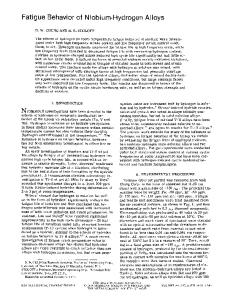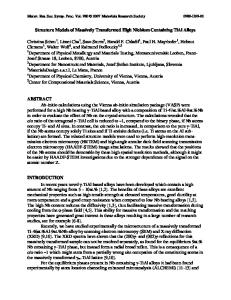Aging behavior of Fe-30 Ni alloys containing niobium
- PDF / 1,636,497 Bytes
- 7 Pages / 569 x 813.28 pts Page_size
- 53 Downloads / 370 Views
A study has been made of the precipitation reactions in Fe-30 wt pet alloys containing up to 5 wt pot Nb. The as-quenched structures of these alloys consist of austenite, martensite in twinned as well as in massive form, and Ni3Nb and FezNb precipitates. O~ aging at 700~ and 800~ the main precipitation reaction results in the formation of hexagonal Laves phase Fe2Nb, but Ni3Nb in both bct and orthorhombic structures also precipitates. The precipitation of Fe~Nb is a heterogeneous process and results in a considerable increase in the hardness of the alloy.
IN
r e c e n t y e a r s nickel s t e e l s m~d s u p e r a l l o y s have found an i n c r e a s i n g use in applications that r e q u i r e a combination of high strength, ductility, and c o r r o s i o n r e s i s t a n c e at high t e m p e r a t u r e s . T h e s e applications have also led to an i n c r e a s e d i n t e r e s t in the p r e c i p i t a tion hardening c h a r a c t e r i s t i c s of n i c k e l - b a s e alloys. It has been established that in n i o b i u m - b e a r i n g a u s t e n i tic s t e e l s ''2 as well as in f e r r i t i c 3 s t e e l s , the L a v e s phase Fe2Nb can produce c o n s i d e r a b l e p r e c ip it a t io n strengthening. It has a l s o been shown that the p r e c i p i tating phase in nickel a u s t e n i t i c s t e e l s containing niobium can be y ' . This is a m e t a s t a b l e phase and c a u s e s c o n s i d e r a b l e strengthening due to its fine distribution and c oh eren cy with the m a t r i x . 4 The y ' phase, which also f o r m s in nickel alloys containing titanium and aluminum, has an o r d e r e d fcc Cu3Au type of s t r u c t u r e s and o v e r a g e s to a c o u r s e d i s p e r s i o n of stable orthor h o m b i c Ni3Nb phase in alloy containing niobium ~ and cph NisTi phase in alloy containing titanium. The l a t t i c e p a r a m e t e r s o r t h o r h o m b i c of Ni3Nb a r e a = 4.21A, b = 5.11A, and c = 4.52,~. Manenc e t al. 7 found that an F e- 3 0 Ni-hNb wt alloy in the a s - q u e n c h e d condition was a u s tenitic and that FeTNbz p r e c i p i t a t e d upon aging above 700~C. However, Kirman s s u g g e s t s that aging F e - 3 0 Ni containing niobium in this temperature range should cause FezNb to precipitate. Denham e t al., z working on Fe-16Ni-16Cr-Nb austenitic steels, have identified Fe2Nb to be the main precipitating phase. In order to investigate the precipitation strengthening characteristics of nickel-bearing alloys further, work was initiated on the age-hardenable Fe-30 Ni alloys. This paper is concerned with the quench-aging behavior of Fe-30 Ni alloy containing niobium.
I) MATERIALSAND EXPERIMENTAL TECHNIQUES The composition of the alloys studied is given in Table L 50 g melts of the alloys were made from high purity alloying elements in an argon arc furnace. These alloys were hot rolled at 850~ to 900~ The total homogenization time was about 75 hr at 1250~ For all the heat treatments, specimens were encapsulated in vycor tubing under ~ aim of argon. For
Data Loading...











